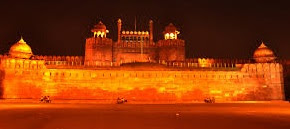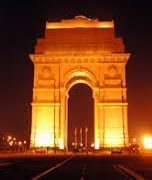ABOUT RED FORT
Shah Jahan appointed development of the Red Fort on 12 May 1638, when he chose to move his capital from Agra to Delhi. Initially red and white, the Shah's most loved colours, Its plan is credited to engineer Ustad Ahmad Lahouri, who additionally built the Taj Mahal. The post lies along the Yamuna River, which bolstered the channels encompassing the greater part of the walls. Construction started in the consecrated month of Muharram, on 13 May 1638. Supervised by Shah Jahan, it was finished on 6 April 1648. Unlike other Mughal strongholds, the Red Fort's limit dividers are awry to contain the more seasoned Salimgarh Fort. The fortification royal residence was a point of convergence of the medieval city of Shahjahanabad, which is available day Old Delhi. Its arranging and feel speak to the peak of Mughal innovativeness winning during Shah Jahan's reign.[citation needed] His successor Aurangzeb added the Pearl Mosque to the ruler's private quarters, developing barbicans before the two primary entryways to make the passageway to the royal residence more circuitous.
Every year on India's Independence Day (15 August), the Prime Minister of India hoists the National flag at the Red Fort and delivers a nationally broadcast speech from its ramparts.
Places for visit inside the Red Fort
Diwan-E-Aam
The inward principle court to which the Nakkar Khana drove was 540 feet (160 m) wide and 420 feet (130 m) profound, encompassed by monitored galleries. On the far side is the Diwan-E-Aam, the Open Group of spectators Corridor.
The corridor's segments and engrailed curves show fine craftsmanship, and the lobby was initially designed with white chunam stucco. In the back in the raised break the ruler gave his group of spectators in the marble overhang.
The Diwan-E-Aam was likewise utilized for state functions. The yard behind it prompts the royal condos.
Mumtaz Mahal
The two southernmost pavilions of the palace are Zenanas (women's quarters), consisting of the Mumtaz Mahal and the larger Rang Mahal. Now the Mumtaz Mahal houses the Red Fort Archaeological Museum.
Diwan-E-Khas
A gate on the north side of the Diwan-E-Aam leads to the innermost court of the palace (Jalau Khana) and the Diwan-E-Khas (Hall of Private Audience). It is constructed of white marble, inlaid with precious stones. The once-silver ceiling has been restored in wood. François Bernier described seeing the jewelled Peacock Throne here during the 17th century. At either end of the hall, over the two outer arches
Lahori Gate
Shah Jahan appointed development of the Red Fort on 12 May 1638, when he chose to move his capital from Agra to Delhi. Initially red and white, the Shah's most loved colours, Its plan is credited to engineer Ustad Ahmad Lahouri, who additionally built the Taj Mahal. The post lies along the Yamuna River, which bolstered the channels encompassing the greater part of the walls. Construction started in the consecrated month of Muharram, on 13 May 1638. Supervised by Shah Jahan, it was finished on 6 April 1648. Unlike other Mughal strongholds, the Red Fort's limit dividers are awry to contain the more seasoned Salimgarh Fort. The fortification royal residence was a point of convergence of the medieval city of Shahjahanabad, which is available day Old Delhi. Its arranging and feel speak to the peak of Mughal innovativeness winning during Shah Jahan's reign.[citation needed] His successor Aurangzeb added the Pearl Mosque to the ruler's private quarters, developing barbicans before the two primary entryways to make the passageway to the royal residence more circuitous.
Every year on India's Independence Day (15 August), the Prime Minister of India hoists the National flag at the Red Fort and delivers a nationally broadcast speech from its ramparts.
Places for visit inside the Red Fort
Diwan-E-Aam
The inward principle court to which the Nakkar Khana drove was 540 feet (160 m) wide and 420 feet (130 m) profound, encompassed by monitored galleries. On the far side is the Diwan-E-Aam, the Open Group of spectators Corridor.
The corridor's segments and engrailed curves show fine craftsmanship, and the lobby was initially designed with white chunam stucco. In the back in the raised break the ruler gave his group of spectators in the marble overhang.
The Diwan-E-Aam was likewise utilized for state functions. The yard behind it prompts the royal condos.
Mumtaz Mahal
The two southernmost pavilions of the palace are Zenanas (women's quarters), consisting of the Mumtaz Mahal and the larger Rang Mahal. Now the Mumtaz Mahal houses the Red Fort Archaeological Museum.
Diwan-E-Khas
A gate on the north side of the Diwan-E-Aam leads to the innermost court of the palace (Jalau Khana) and the Diwan-E-Khas (Hall of Private Audience). It is constructed of white marble, inlaid with precious stones. The once-silver ceiling has been restored in wood. François Bernier described seeing the jewelled Peacock Throne here during the 17th century. At either end of the hall, over the two outer arches
Lahori Gate







































